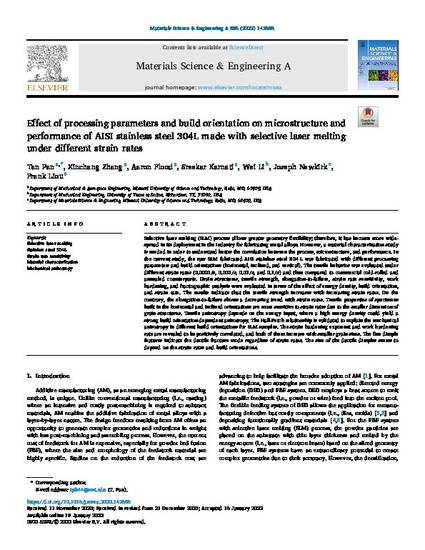
Selective laser melting (SLM) process allows greater geometry flexibility; therefore, it has become more widespread in its deployment in the industry for fabricating metal alloys. However, a material characterization study is needed in order to understand better the correlation between the process, microstructure, and performance. In the current study, the raw SLM fabricated AISI stainless steel 304 L was fabricated with different processing parameters and build orientations (horizontal, inclined, and vertical). The tensile behavior was evaluated under different strain rates (0.0001/s, 0.001/s, 0.01/s, and 0.1/s) and then compared to commercial cold-rolled and annealed counterparts. Grain structures, tensile strength, elongation-to-failure, strain rate sensitivity, work hardening, and fractographic analysis were evaluated in terms of the effect of energy density, build orientation, and strain rate. The results indicate that the tensile strength increases with increasing strain rates. On the contrary, the elongation-to-failure shows a decreasing trend with strain rates. Tensile properties of specimens built in the horizontal and inclined orientations are more sensitive to strain rates due to the smaller dimension of grain structures. Tensile anisotropy depends on the energy input, where a high energy density could yield a strong build orientation-dependent anisotropy. The Hall-Petch relationship is validated to explain the mechanical anisotropy in different build orientations for SLM samples. The strain hardening exponent and work hardening rate are revealed to be positively correlated, and both of them increase with smaller grain sizes. The fine dimple features indicate the ductile fracture mode regardless of strain rates. The size of the ductile dimples seems to depend on the strain rates and build orientations.
- Material characterization,
- Mechanical anisotropy,
- Selective laser melting,
- Stainless steel 304L,
- Strain rate sensitivity
Available at: http://works.bepress.com/frank-liou/358/

National Science Foundation, Grant CMMI 1625736